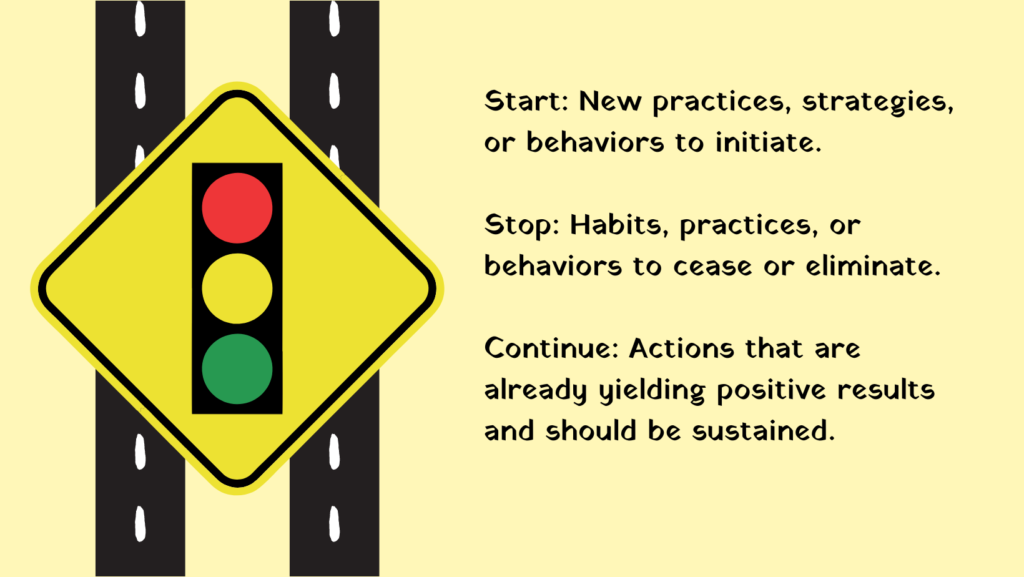Imagine attending a training session or workshop with high expectations of acquiring new skills or knowledge, only to return to your workplace and find that nothing has changed. This frustrating scenario is all too common in the world of professional development. Many organizations invest time and resources into training their employees, only to see little to no actual improvement in job performance. So, how can this gap between learning and application be bridged effectively? Enter the Start-Stop-Continue (SSC) model—an elegantly simple yet immensely powerful tool for creating a Learning Action Plan that drives meaningful change.
Introducing Start-Stop-Continue
The Start-Stop-Continue model is a strategic tool that provides a structured framework for creating a Learning Action Plan. This model encourages participants to reflect on their current practices and identify three key areas:

By focusing on these three areas, individuals can create a practical plan that guides their actions after the learning experience. The SSC model is particularly effective due to its simplicity and adaptability across various contexts.
Pros and Cons of Start-Stop-Continue
 Pros:
Pros:
Clarity and Focus: The SSC model promotes clear thinking by prompting participants to categorize their actions. This clarity enhances their ability to prioritize and execute their Learning Action Plan.
Action-Oriented: Instead of passively absorbing knowledge, participants actively engage with the content by planning specific actions to take. This boosts the likelihood of successful implementation.
Customization: The model can be tailored to individual needs, ensuring that the action plan aligns with personal goals and job roles.
Encourages Reflection: The process of identifying what to start, stop, and continue necessitates reflection on current practices, fostering a deeper understanding of strengths and weaknesses.
Cons:
Simplicity Could Lead to Shallow Plans: The simplicity of the SSC model might tempt participants to create superficial plans. It’s crucial to encourage thoughtful consideration and comprehensive planning.
Lack of Accountability: Without proper follow-up and accountability mechanisms, participants might not fully commit to their action plans.
Effective Implementation Tips
The power of the Learning Action Plan lies in its execution. Here are some tips to ensure the effective implementation of the Start-Stop-Continue model:
Set Specific Goals: Clearly define what you want to achieve with your Learning Action Plan. Specific goals provide direction and purpose.
Prioritize: Don’t overwhelm yourself with too many changes. Focus on a few key actions that will have the most significant impact.
Create Measurable Objectives: Ensure that your action plan includes measurable objectives. This allows you to track progress and celebrate achievements.
Allocate Resources: Identify the resources—such as time, tools, and support—you’ll need to successfully implement your plan.
Regular Review and Adaptation: Schedule regular check-ins to review your progress, adjust strategies as needed, and celebrate successes.
Seek Accountability: Share your Learning Action Plan with a colleague, mentor, or supervisor who can provide support and hold you accountable.
Want to build a powerful strategy to ensure application of learning in the workplace? Check out ExeQserve’s Competency-based Learning and Development Training
The Tool’s Power Lies in the Wielder
It’s important to remember that a Learning Action Plan, no matter how well-structured, is only a tool. Its effectiveness is determined by the individual wielding it. Commitment, effort, and a genuine desire for growth are the driving forces behind turning a plan into concrete results. The Start-Stop-Continue model equips learners with a roadmap, but it’s their dedication that ultimately transforms learning into impactful change.
The Start-Stop-Continue model offers a refreshing approach to tackling the learning-application gap. By focusing on what to start, stop, and continue, individuals can create a tailored action plan that drives real change. While the model is elegantly simple, its impact is profound. Remember, the true power of a Learning Action Plan lies in the hands of those who use it with determination and purpose.








